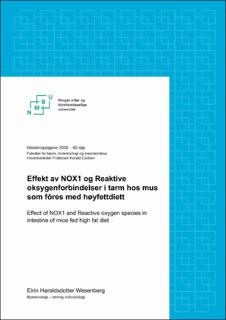| dc.contributor.advisor | Carlsen, Harald | |
| dc.contributor.advisor | Herfinndal, Anne Mari | |
| dc.contributor.advisor | Papoutsis, Dimitris | |
| dc.contributor.advisor | Rocha, Sergio | |
| dc.contributor.author | Wesenberg, Eirin Haraldsdotter | |
| dc.date.accessioned | 2021-02-01T11:59:54Z | |
| dc.date.available | 2021-02-01T11:59:54Z | |
| dc.date.issued | 2020 | |
| dc.identifier.uri | https://hdl.handle.net/11250/2725563 | |
| dc.description.abstract | Bakgrunn: Et velfungerende fordøyelsessystem er viktig for både mental og fysisk helse. Særlig er et kontrollert miljø og symbiotisk mikrobiom i nederste del av tynntarm svært viktig, da hovednæringsopptak skjer i dette området. Reaktive oksygenforbindelser (ROS) dannes i alle celler i kroppen, men særlig NADPH oksidaser (NOX) er assosiert med produksjonen av disse. NOX1 som produserer superoksid er særlig oppregulert i ileum, men den nøyaktige rolle av NOX1, eller effekt av ROS i ulike situasjoner er fortsatt uklart.
Hensikt: Av den grunn ønsket vi å undersøke effekten av NOX1 i C57BL/6-hannmus fôret på høyfettdiett med og uten fababønnefraksjon på mikrobiotasammensetningen og –antallet. Særlig ble det ønsket å indusere overvekt i musene, som har blitt assosiert med mikrobiell dysbiose, og å undersøke om ROS eller fababønnefraksjon bidro til forbedret tarmhelse.
Metoder: Villtypemus og NOX1-knockout mus ble fôret med høyfettdiett med eller uten fababønnefraksjon for å indusere overvekt. Videre ble ROS-produksjon i mageregion målt in vivo ved bruk av en kjemiluminescerende probe. Den relative mikrobiotasammensetning i ileum og cøkum ble funnet gjennom 16S rRNA-sekvensering. Kvantifisering av antall bakterier ble gjort flowcytometrisk ved bruk av tellekuler. Før kvantifiseringen kunne gjøres måtte nedgang i celletall kvantifiseres som et resultat av lagringstid etter prøveuttak.
Resultater: Gjennom prosjektet ble det sett at dietten førte til overvektig fenotype sammenlignet med mus fôret på standarddiett, samt at fravær av NOX1 kraftig reduserte det L-012-medierte lyssignaet. Videre ble det sett økt antall unike arter i cøkum sammenlignet med ileum, samt generell reduksjon av artsantallet i forsøksmusene fôret med høyfettdiett. Det ble også observert dysbioseassosiert mikrobiotasammensetning både på fylumnivå og slektsnivå både i ileum og cøkum, og en antydning til økning i mikrobiotakvantitet i NOX1ko-musene sammenlignet med VT-musene. Fababønnefraksjonen i dietten viste tegn til å øke mengden av visse symbiotiske slekter, samt å holde bakteriemengden nede i ileum.
Konklusjon: Til sammen ga resultatene en viss indikasjon på at NOX1-indusert ROS har en regulativ effekt på mikrobiotasammensetning og –kvantitet, samt at fababønnefraksjon kunne motvirke noen av de dysbioseassosierte effektene skapt av høyfettdietten. | en_US |
| dc.description.abstract | Background: A well functioning digestive system is important both for mental and physical health. Specifically, a controlled environment and symbiotic microbiome in the lower part of the small intestine is very important, as the main nutrient uptake takes place in this area. Reactive oxygen species (ROS) are created in all cells of the body, but especially NADPH oxidases (NOX) are associated with the production of these. NOX1 is upregulated in ileum, but the exact role of this enzyme, or the effect of ROS in different settings is still unclear.
Purpose: For this reason, we wanted to investigate the effect of NOX1 in C57BL/6 male mice, fed on a high fat diet with or without a faba bean fraction in the microbiota composition and count. There were specifically an intent to introduce obesity in the mice as has been associated with microbial dysbiosis, and to investigate if ROS or faba bean fraction contributed to better intestinal health.
Methods: Wild type and NOX1 knockout (NOX1ko) mice were fed with a high fat diet with or without a faba bean fraction in order to induce obesity. Further, the ROS production in the abdominal region was measured in vivo through use of a chemically luminescent probe. The relative composition of microbiota in ileum and cecum were sequenced using the 16S rRNAgenes. Quantification of the number of bacteria were done through flow cytometry by the use of counting beads. Before the flow cytometric quantification could take place, the possible reduction in cell count had to be quantified as a result of storage time after sampling.
Results: The project showed that the diet led to an obese phenotype compared to mice fed with a standard diet, and that the absence of NOX1 strongly reduced the L-012 mediated light signal. An increased number of unique species were observed in the cecum, as compared to ileum, though reduction in operational taxonomic units were associated with the high fat diet in all the test groups. A dysbiotic associated microbiome composition was observed both at the phylum and genus level in the cecum, and a tendency to increased micro biotic quantity in the NOX1ko mice as compared to the WT mice. The faba bean fraction of the diet showed signs of increasing the amount of certain symbionts, as well controlling the bacteria load in ileum low.
Conclusion: Taken together, the results gave a certain indication that the NOX1 produced ROS had a regulatory effect on the microbiotic composition and quantity, and that the faba bean fraction could counteract some of the dysbiotic effects associated with the high fat diet. | en_US |
| dc.language.iso | nob | en_US |
| dc.publisher | Norwegian University of Life Sciences, Ås | en_US |
| dc.rights | Attribution-NonCommercial-NoDerivatives 4.0 Internasjonal | * |
| dc.rights.uri | http://creativecommons.org/licenses/by-nc-nd/4.0/deed.no | * |
| dc.title | Effekt av NOX1 og Reaktive oksygenforbindelser i tarm hos mus som fôres med høyfettdiett | en_US |
| dc.title.alternative | Effect of NOX1 and Reactive oxygen species in intestine of mice fed a high fat diet | en_US |
| dc.type | Master thesis | en_US |
| dc.source.pagenumber | 88 | en_US |
| dc.description.localcode | M-BIOTEK | en_US |

